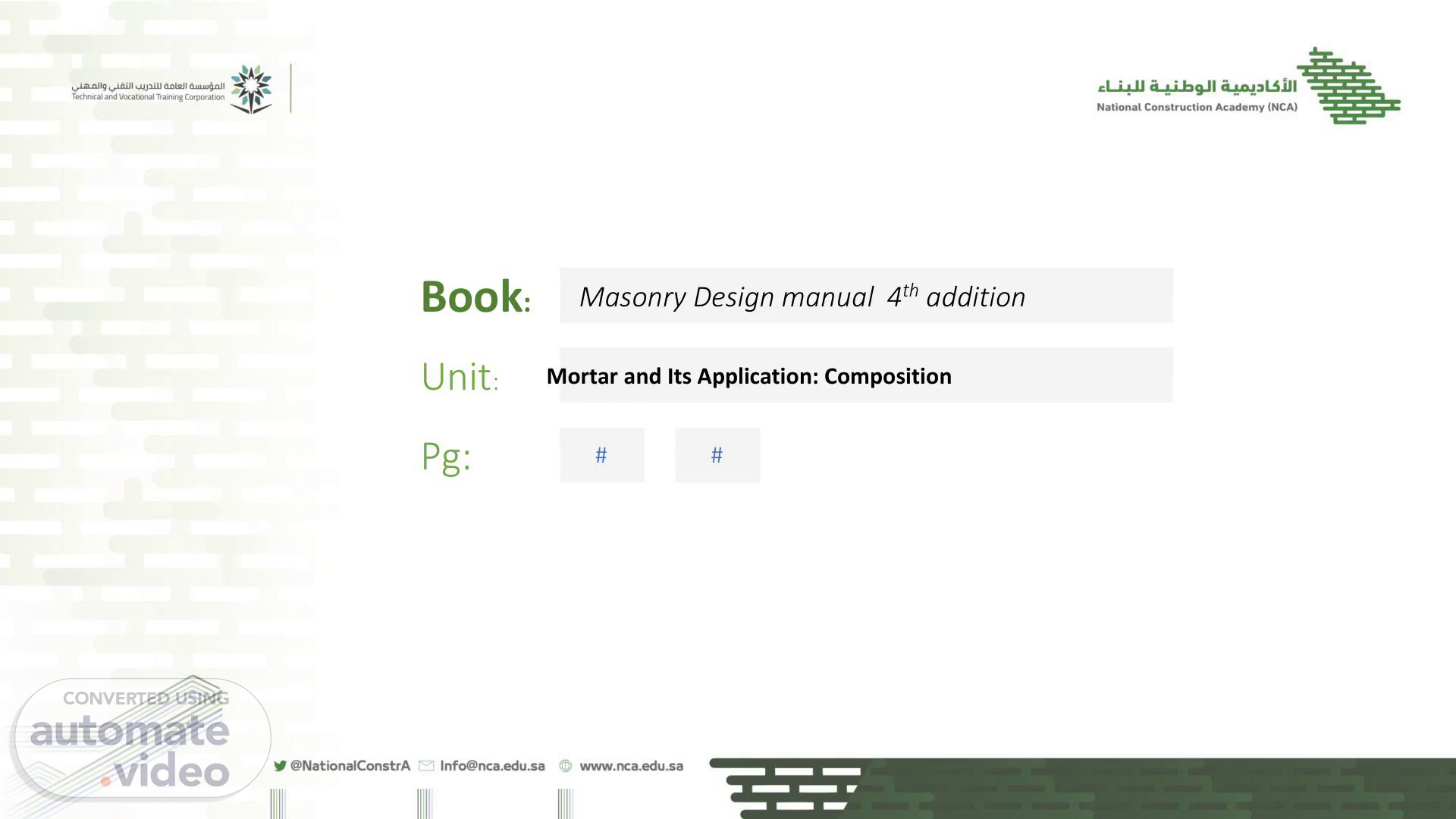Scene 1 (0s)
[Audio] Masonry Design manual 4th addition Book: Mortar and Its Application: Composition Unit: # # Pg:.
Scene 2 (9s)
[Audio] Subtitle Based on the K-S-A Building Code and Masonry Design Manual 4th Edition.
Scene 3 (17s)
[Audio] Introduction Overview: o Mortar is essential in masonry construction for binding blocks, providing stability, and improving durability. o Understanding its composition and application is crucial for optimal performance and structural integrity. Laying heavy hollow Blocks! #bricklaying #blocklaying #construction (youtube.com).
Scene 4 (44s)
[Audio] Vocabulary Mortar: A mixture used to bond masonry units. Block Laying: The process of placing bricks or blocks together with mortar to form walls or structures. Joint Thickness: The space filled with mortar between masonry units. Compressive Strength: The ability of mortar to resist load..
Scene 5 (1m 5s)
[Audio] Objective o To understand mortar composition, types, and their application in block laying. To explore best practices for mortar mixing and block laying in compliance with Saudi Building Code and other relevant standards (1) QUIKRETE Mason Mix (Product Feature) YouTube.
Scene 6 (1m 24s)
[Audio] Key Terms Mortar Composition: Mixture of cement, lime, sand, and water. Workability: Ease with which the mortar can be spread and used in block laying. Bond Strength: Ability of the mortar to hold masonry units together. Water Retention: The capacity of the mortar to retain water and ensure good hydration. (1) 3 Great Tips for Block-work | Build A Foundation YouTube.
Scene 7 (1m 52s)
[Audio] Key Points Composition of Mortar Ingredients: o Cement: Provides strength. o Lime: Enhances workability and flexibility. o Sand: Acts as a filler to reduce shrinkage and control texture. o Water: Activates the chemical reaction for binding. Mixing Ratio: Depends on project requirements (for example, 1:3:12 for lime mortar in historical buildings)..
Scene 8 (2m 25s)
[Audio] Key Points Types of Mortar Cement Mortar: High compressive strength, suitable for load-bearing walls. Lime Mortar: Flexible and breathable, often used in restoration. Gypsum Mortar: Quick setting, used for nonload-bearing interior walls. Mixed Mortar (Cement-Lime Mortar): Combines the strength of cement and flexibility of lime. (1) How to mix mortar, perfect creamy mix for bricklaying YouTube.
Scene 9 (2m 58s)
[Audio] Best Practices in Applying Mortar for Block Laying Surface Preparation: o Ensure clean, dust-free surfaces. o Pre-wet blocks to enhance adhesion. Mixing Mortar: o Follow prescribed ratios. o Mix uniformly for consistent texture. Application: o Use trowel to spread mortar evenly. o Maintain joint thickness as per code (10 millimeters is common in many standards). o Avoid re-tempering once mortar starts to set. TROWEL method with the Speedymason Full-bed Mortar System #thinbrick #mortar #shorts (youtube.com).
Scene 10 (3m 36s)
[Audio] Compliance with Saudi Building Code Mortar Requirements (Refer to the Saudi Building Code): o Properly proportioned mortar mixes for various block types. o Specification of compressive strength and durability. o Guidelines for joint thickness and water resistance. Masonry Design Manual 4th Edition: o Reference for mortar selection, especially for specific environments (for example, coastal regions). o Guidelines for best block-laying practices..
Scene 11 (4m 10s)
[Audio] Case Studies/Questions Case Study 1: Analyzing failures in block walls due to poor mortar application. Case Study 2: Impact of incorrect mixing ratios on the durability of walls. Questions for Discussion: o What factors can affect the bond strength of mortar in block walls? o How can different mortar types influence the longevity of masonry structures?.
Scene 12 (4m 35s)
[Audio] Summary Mortar plays a critical role in masonry construction. Understanding its composition and types allows for better performance and durability in building. Compliance with the Saudi Building Code and standards like the Masonry Design Manual ensures safe and long-lasting structures..
Scene 13 (4m 55s)
[Audio] References K-S-A Building Code – Saudi Standards, Metrology, and Quality Organization (S-A-S-O-). Masonry Design Manual (4th Edition) – The Masonry Society. ASTM C270 – Standard Specification for Mortar for Unit Masonry. ACI 530 – Building Code Requirements and Specifications for Masonry Structures.
